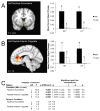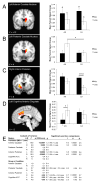Altered brain response to reward and punishment in adolescents with Anorexia nervosa
- PMID: 24148909
- PMCID: PMC3880152
- DOI: 10.1016/j.pscychresns.2013.07.004
Altered brain response to reward and punishment in adolescents with Anorexia nervosa
Abstract
Adults recovered from Anorexia nervosa (AN) have altered reward modulation within striatal limbic regions associated with the emotional significance of stimuli, and executive regions concerned with planning and consequences. We hypothesized that adolescents with AN would show similar disturbed reward modulation within the striatum and the anterior cingulate cortex, a region connected to the striatum and involved in reward-guided action selection. Using functional magnetic resonance imaging, twenty-two adolescent females (10 restricting-type AN, 12 healthy volunteers) performed a monetary guessing task. Time series data associated with monetary wins and losses within striatal and cingulate regions of interest were subjected to a linear mixed effects analysis. All participants responded more strongly to wins versus losses in limbic and anterior executive striatal territories. However, AN participants exhibited an exaggerated response to losses compared to wins in posterior executive and sensorimotor striatal regions, suggesting altered function in circuitry responsible for coding the affective context of stimuli and action selection based upon these valuations. As AN individuals are particularly sensitive to criticism, failure, and making mistakes, these findings may reflect the neural processes responsible for a bias in those with AN to exaggerate negative consequences.
Keywords: Anorexia nervosa; Cingulate; Functional magnetic resonance imaging; Reward; Striatum.
Copyright © 2013 Elsevier Ireland Ltd. All rights reserved.
Figures




References
-
- Abler B, Erk S, Walter H. Human reward system activation is modulated by a single dose of olanzapine in healthy subjects in an event-related, double-blind, placebo-controlled fMRI study. Psychopharm (Berl) 2007;191:823–833. - PubMed
-
- American Psychiatric Association; Association AP, editor. Diagnostic & Statistical Manual of Mental Disorders: DSM:VI-TR. 4. Washington, DC: 2000.
-
- Balleine B. The integrative function of the basal ganglia in instrumental conditioning. Behav Brain Res. 2009;199:43–52. - PubMed
-
- Benjamini Y, Hochberg Y. Controlling the false discovery rate: a practical and powerful approach to multiple testing. J Royal Statist Soc B-Methodological. 1995;57
-
- Botvinick M, Cohen J, Carter C. Conflict monitoring and anterior cingulate cortex: an update. Trends Cogn Sci. 2004;8:539–546. - PubMed
Publication types
MeSH terms
Grants and funding
LinkOut - more resources
Full Text Sources
Other Literature Sources
Medical
Research Materials

